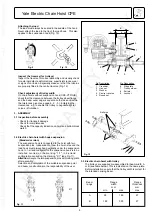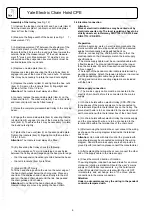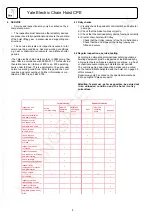
4
• The hoist / trolley can be operated in ambient temperatures
C. Consult the manufacturer in
case of extreme working conditions.
At ambient temperatures below 0
• The accident prevention act and/or safety regulations of
the respective country for using manual and electric hoists
must be strictly adhered to. In Germany these are VBG 8,
VBG 9, VBG 9a, ZH 1/25, ZH 1/27, and VDE 0100 resp.
• In order to ensure correct operation, not only the operating
instructions, but also the conditions for inspection and
maintenance must be complied with. If defects are found
stop using the hoist / trolley immediately.
Before starting work on electrical components
switch OFF the main current switch and secure it against
unintentionally being switched back on.
• Do not exceed the rated capacity of the hoist / trolley.
• Do not use the hoist / trolley for the transportation of
• Welding on hook and load chain is strictly forbidden. The
load chain must never be used as a ground connection during
• Avoid side pull, i.e. side load on either housing or bottom
block (Fig. 5). Lift only when the load chain froms a straight
• The load chain must not be used for lashing purposes (sling
• Do not knot or shorten the load chain by using bolts, screws,
screwdrivers or other devices (Fig. 7). Do not repair chains
• Do not remove the saftety latch from the suspension or
• Do not use the chain end stop as an operational limit device
(see Fig. 1 - chain end stop).
• Do not throw the hoist hoist or trolley down. Always place it
Inspection before initial operation
Each hoist / trolley must be inspected prior to initial operation
by a competent person and any failures be removed. The
inspection is visual and functional and shall establish that
the hoist is safe and has not been damaged by incorrect
transport or storage. Inspections should be made by a
representative of the manufacturer or the supplier although
the company can assign its own suitably trained personnel.
Inspections are instigated by the user.
Inspection before starting work
Before starting work inspect the hoist / trolley, chains and all
load bearing components every time for visual defects.
Furthermore test the brake and make sure that the load and
hoist / trolley are correctly attached by carrying out a short
work cycle of lifting and lowering resp. travelling in both
directions. Selection and calculation of the proper suspension
point and beam construction are the responsibility of the user
Inspect the chain for sufficient lubrication any visually check
for external defects, deformations, superficial cracks, wear
The chain end stop must be connected to the free (idle) chain
strand (see Fig. 1 - chain end stop).
All units with two or more chain strands should be inspected
prior to initial operation for twisted or kinked chains. The
chains of 2-strand hoists may be twisted if the bottom block
Inspection of suspension and load hooks
Inspect suspension and load hooks for deformations,




































